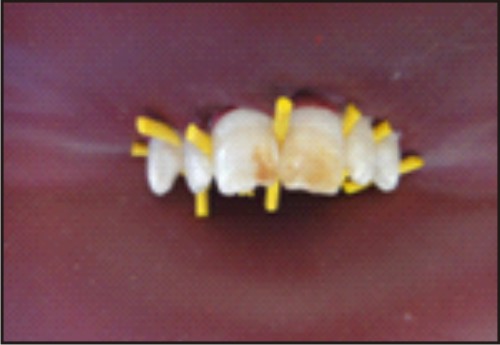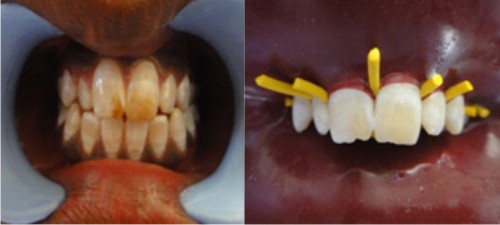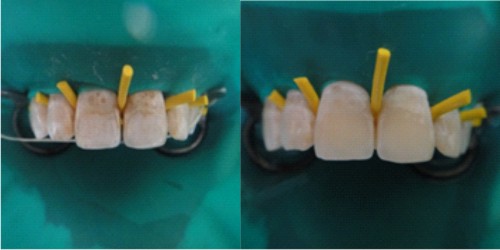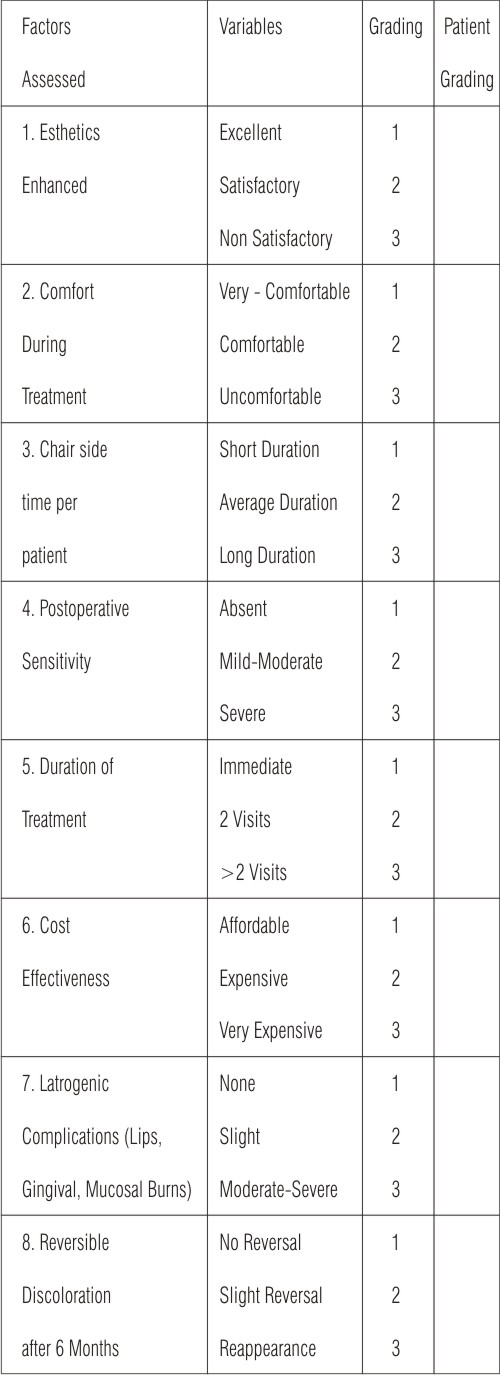Introduction
“You can only hold a smile for so long, after that it's just teeth.” - Chuck Palahniuk. Smiles are instinctive, a universal sign of friendliness. Smile is a major expression of emotions like happiness, love and excitement. Esthetics: Appreciative of, responsive to, or zealous about the beautiful; having a sense of beauty or fine culture.It can enhance personal and professional relationships and inspire others in many ways. Yet too often, our teeth deny us the benefits of a beautiful smile. They ruin the looks through discoloration. It's a physical handicap and put a badimpact upon person's self-image, self-confidence and physical attraction.Our society tends to dislike yellowing of teeth that comes with age or the various intrinsic stains that occur developmentally.The color of the teeth is in?uenced by a combination of their intrinsic color and the presence of any extrinsic stains that may form on the tooth surface.The desire to have white teeth and thus a more pleasant smile has become an important esthetic need of patients today .Cosmetic or aesthetic dentistry can help us to achieve whatever it is we see in the mirror of our mind's eye.The current trend toward cosmetic dentistry has generated more interest in bleaching as patients are asking for whiter and more beautiful teeth and do not want their teeth to be cut down. It is a conservative method of treating dentition discolored by ingested substances, fluorosis, or other causes .There have been tremendous advancements in bleaching materials and techniques to provide more natural and life-like solutions to aesthetic issues with discolored teeth either intrinsic or extrinsic. My study is for the use of Mc Innes solution in clinical practice which is completely forgotten in spite of that it conserves the tooth structure as compared to other modalities. It is one of the most documented clinical techniques in dentistry and yet for reasons unknown, it has escaped the acceptance that it deserves in day to day clinical practice.The successful outcome of this solution mainly depends on the patient-related factors: the patient's needs, age, expectations and affordability. The clinician-related factors include the availability of bleaching materials and a thorough knowledge of the material science, including methodologies and techniques involved.A step-wise approach to treatment is promoted to encourage the most conservative solution to achieve appreciable aesthetics.
 | What is McInnes Solution? (Figure 1)
 |
5 Parts 35% hydrogen peroxide-bleaches the enamel
5 Parts 30% hydrochloric acid-etches the enamel
1 Part diethyl ether- removes the facial debris
This case series surveyed the various aspects of McInnes solution emphasizing on advantages of this solution in today's domain of dental bleaching.
Complete Care - Assessment & Diagnosis
Before bleaching procedure, it should follow a comprehensive examination, record taking, diagnosis and custom treatment plan. Once it has been determined what the patients want and what exact conditions are, they can be given choices for cosmetic care that meet theirdesires in a personalized way.
Case Reports
Chief Complaint:Patients reported to the Department of Conservative Dentistry and Endodontics with:
1. Discolored anterior teeth demanding appreciable esthetic outcome.
2. Prime importance was given to the conservation of tooth structure.
Case Selection:With the inclusion and exclusion criteria (Table 1), after taking the informed consent, 25 patients selected with mild to moderate enamel fluorosis according to Dean's Fluorosis Index.
 | Table I
 |
Treatment Protocol:
Patients informed about the diagnosis, the approximate treatment time and number of sittings.Pre -operative pictures were taken. Oral prophylaxis done judiciously with pumice paste to remove the surface stains. Coating ofbuccal and palatal gingiva, lips and mucosa was done with ora-base. Application of rubber dam was done. (Figure 2)
 | Figure 2
 |
Isolated teeth were rubbed with freshly prepared McInnes solution for 5 minutes at 1 minute intervals each. Then it was copiously irrigated with normal saline. Rubber dam was removed. Polishing was done with polishing paste. Post -operative pictures were taken and shown to the patients to assess the immediate results.
Case 1
 | PRE-OPERATIVE POST-OPERATIVE
 |
Case 2
 | PRE-OPERATIVE POST-OPERATIVE
 |
Case 3
 | PRE-OPERATIVE POST-OPERATIVE
 |
After completion of the treatment:Each patient was given a separate performa (Table 3) with 8 factors to be assessed with scores 1/2/3 + A self -analytic grading system (Table 4) to evaluate the bleaching procedure with McInnes solution.
Table 3
Grading System: Scoring (Table 4)
Results/Outcome:The grading criteria on an average with all cases show APPRECIABLE RESULTS. (9 - 16 Scoring).
Discussion:The record made out from patient's analytical score system perfectly gives a picture that McInnes solution can be well accepted for clinical day to day practice as bleaching solution. Although a wide arena of esthetic restorative materials are available to us today for the management of discolored anterior teeth, bleaching with Mc Innes Solution still remains a viable option.Definitely bleaching with McInnes solution is simple, inexpensive,
 | Assessment Performa After Bleaching With McInnes Solution
Name Of The Patient:
Place of Birth / Residence:
Age:
Sex:
Occupation:
Chief Complaint:
Factors Assessed:
 |
 | Grading System: Scoring (Table 4)
 |
 | The factors assessed can be summarized as:
 |
gives instant results, not dependent on patient's compliance as other office based procedures, no heat is required to activate the bleaching solution, no dehydration of the tooth occurs with no damage to the pulp.
The solution also allows individuals with normal range dentition to whiten their teeth to meet cosmetic demands. Bleaching with this solution isesthetically pleasing and minimally invasive option for young patients rather than a complete coronal coverage. It can be successfully carried out at various times. The successful outcome depends mainly on the etiology, correct diagnosis and proper selection of bleaching technique. It requires less chair-time, safe, more comfortable for the patients;impart tremendous patient satisfaction as the results are immediate. The solution is useful for the removal of stains throughout the arch or even treating specific areas of a single tooth (such as in some types of fluorosis). The dentist is in complete control of the process throughout treatment. This provides the advantage of continuing the treatment or terminating the bleaching process at any time. It is a fast process that the results are evident even after a single visit. Many patients prefer bleaching by the dental professional because it requires less active participation on their part.
The role of McInnes solution as a bleaching agent is fully justified. But with the increasing esthetic demand, patient demands for enhanced esthetic procedures like composite veneering, laminates, crowns etc.
Bleaching with McInnes solution is bit technique sensitive, as it is a chemical, acidic in nature. So, precision on a part of dentist is important.Some patients report a metallic taste sensation immediately after bleaching; however, this normally disappears after few hours. Tooth sensitivity, if this has occurred, the patient should be reassured that this is a common side effect and will disappear after bleaching. Patients should be reassured that the side effects are minor and transient and will disappear after the completion of treatment.
Conclusion
Bleaching techniques that have been shown to be relatively and reasonably safe and effective, both in current usage and over time should be accepted as a reasonable treatment option,knowing the risks and benefits. Effectiveness and safety of the bleaching technique must evaluate not only the product, but also the delivery method and treatment time.
The success of my study explored the successful usage of McInnes solution alone in day to day clinical practice which emerges hereby as a phoenix solution in today's dental practice which had been completely forgotten with latest tooth whitening modalities.
References
1. I A Pretty, R P Ellwood, P A Brunton, A Aminian. Vital tooth bleaching in dental practice: 1. Professional bleaching. Dent Update 2006; 33:288-304
2. Watts A, Addy M. Tooth discolouration and staining: A review of literature BDJ 2001, 190 (6): 309-316
3. Garber and Goldstein - Complete dental bleaching 1995; 5th Edition; Quintessence Publications
4. Tam L. Vital tooth bleaching review and current status. JCDA 1992; 58(8): 654-63
5. Goldstein C.E., Garber D.A. Bleaching of vital teeth: state of art. Quintessence Publications 20 (10): 729-737, 1989
6. Arens D. Role of bleaching in aesthetics, DCNA 33(2): 319-336, 1989 |